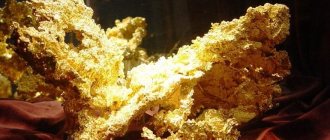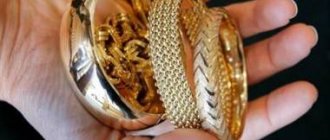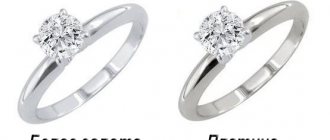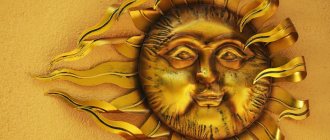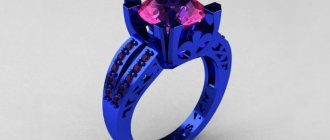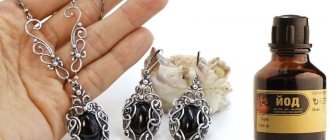What is a gold nugget
A gold nugget is an opaque piece of native gold (ore rock) enriched with minerals. In terms of its chemical composition, it is a frozen natural solution of a compound of silver, precious metal and impurities.
Native gold contains up to 10% of ores found in rock deposits. Combines with iron, copper, platinum, iridium, osmium. The shade of the nugget depends on them.
Description of native gold:
| Options | What it looks like in nature |
| Dimensions | Nuggets include a single piece of gold over 2 grams, the weight sometimes reaches more than 100 kg. Formed in the form of dust (sand), grains less than 5 mm. |
| Color | Yellow (lemon to amber), yellow-red, silver-white, possible greenish tint |
| Color of crushed nugget | Yellow |
| Surface | Dull or bright, with a metallic sheen, smooth or uneven, there are notches, notches. Sometimes covered with another rock (called “shirted”) |
| Form | Bizarre, reminiscent of geometric shapes, plates, animals, feathers, branches and other objects |
| Hardness | Soft, corresponds to 2.5–3 points on the Mohs scale |
| Try | 800–950 (high-quality native gold). The more impurities, the lower the sample |
Often gold is connected to stones because it was formed at the same time as them or crystals began to grow around the precious metal. It occurs inside the mineral, on its surface, or lies separately from the destroyed gem.
There are stones with yellow shiny inclusions, reminiscent of gold. They don't actually contain precious metal.
To see what nuggets look like:
How is it different from pyrite?
Pyrite is a shiny mineral similar to gold. The gem is straw-colored, but when crushed, the powder turns out not yellow, but green-black.
It also differs in cleavage. When native gold is struck, it becomes deformed. Pyrite crumbles into pieces and dust, and can create sparks.
Crystal optical properties in thin preparations (sections)
In polished sections, in reflected light, golden-yellow, shiny. Reflectivity. exceptionally high, depends on the Ag content, for pure gold (in%): for green rays 47.0, for orange 82.5, for red 86. Isotropic. The refractive index (according to Kundt) in prisms for red light is 0.38, for white light 0.58, for blue light 1.00; in reflected light (according to Drude) for Na light 0.366, for red 0.306; the absorption coefficient for Na light is 7.71, for red light 10.2. The ability to polish in small deposits is very good; in larger deposits, even with thorough polishing, scratches from the smallest particles of abrasives and small pinholes remain. 'Structures of replacement and cementation of various minerals with gold are observed.
How to determine the presence of precious metal in a stone
The authenticity of native gold is determined in the field or at home using a folk method.
- If the golden inclusion under the mineral layer is barely noticeable, the stone is chipped or broken. When struck, the precious metal does not crumble.
- Having provided access to the inclusion, its surface is scratched with a steel needle.
- The scratched area is examined through a magnifying glass. The gold-containing element will not be destroyed; lines will remain on it where the needle is pressed.
The presence of gold dust in a stone is checked using iodine. An alcohol tincture from a pharmacy is suitable.
- Grind the mineral into powder.
- Place the mineral powder in a jar or other container.
- Pour iodine into the powder and stir until smooth. Wait until a precipitate forms.
- Immerse a strip of white paper towel or filter paper (2 cm wide) into the liquid so as not to stir up the sediment. Immediately remove and dry at room temperature.
- The action of the previous paragraph is repeated 4–7 times.
- After drying, the paper is placed on a heat-resistant saucer and set on fire. If the stone contains precious metal, the ash will be purple in color.
There are few stones containing gold-bearing inclusions. The precious metal is found in granite, quartz and quartz diorites. Not all shiny minerals are classified as valuable specimens. But varieties of pyrite, sphalerite, galena and stibnite often lie next to the precious metal.
See an alternative option for finding gold:
How are gold nuggets formed and where can you find them?
There is no evidence of exactly how the natural precious metal was formed. Previously it was believed that it increased due to crystallization, as during the formation of granite. Most scientists recognize the original molten state of native gold with the same composition as now. Perhaps the process began during volcanic eruptions, then the metal cooled in the cavities of the rock.
The main deposits of gold nuggets in Russia:
- Natalkinskoye (Omchak river, Magadan region);
NATIVE GOLD (a. native gold; n. gediegenes Gold; f. or natif; i. oro nativo) is a mineral of the class of native elements, Au. Native gold is a natural solid solution of Au = Ag. The Ag content in native gold is 0.n - 10•n%. There are signs of discontinuity in this series: a significantly different prevalence of native gold of different grades (predominance 930-900, 820-780, 650-600, extreme rarity - 550) to golden silver - the so-called kustelite; characteristic phase heterogeneity of native gold individuals with separation of composition phases; Ag, Ag3, Au, AgAu. Impurities of Cu (0.001-0.9%), Fe, Mn, Pb, less often Bi, Sb, Hg, Te, Se, Pt, In, etc. (0.00n - 0.n%) are also common. With increased amounts of impurities, varieties of native gold (mostly rare) are distinguished: cuprous gold, bismuth gold, iridium gold, platinum gold, etc. Natural amalgams of Au are known. Impurities of Ag, Fe and others are often concentrated in the growth zones of native gold individuals and along the boundaries of grains or in their individual areas. Native gold contains inclusions of CO2 and other gases. The composition of native gold depends on the type and depth of formation of deposits, as well as on the geochemical specifics of the regions.
The coordination structure crystallizes into cubic systems. A variety of crystal shapes is characteristic: octahedra, cuboctahedra, and rhombic dodecahedrons are common; more complex shapes are known. At least 80% of the crystals are twinned: (111) twins, often polysynthetic. Along with isometric crystals, some deposits contain distorted crystals (elongated wire-like, hair-like or flattened, thin-lamellar). For shallow deposits, dendrites of native gold are typical, predominantly flat, fern-like, reticulate, star-shaped, etc. The crystals are mostly small (0.00-1 mm), large ones are rare. Crystals up to 3 cm and flat dendrites of native gold with a maximum diameter of up to 10 cm are known. Native gold deposits are distinguished: finely dispersed (up to 10 microns) and “visible” (dust-like, small, medium-sized, large). In most gold deposits, native gold particles of 0.01-4 mm predominate. The largest continuous accumulations of native gold weighing over 1-5 g are nuggets. The largest of them, the “Holterman Plate” from Australia, weighed 93.3 kg. Macca of the largest nugget found in the CCCP - “Big Triangle” (Ural) - 36.2 kg.
Native gold has a bright metallic luster. On the rough surfaces of the “touch stone” it leaves a shiny “golden” line, by the color and brilliance of which one can approximately (in comparison with standards) determine the sample of native gold. As the standard decreases, the color of native gold changes from reddish-yellow (bronze) to straw and cream, often with a greenish tint (accumulations of fine gold in quartz and other minerals are also greenish or tobacco-brown). Density from 19,200 to 15,600 kg/m3 (depending on the composition, porosity and degree of deformation of the particles). Reflectivity R from 41 to 98. Hardness on a mineralogical scale from 2 to 3, in kg/mm 2 - from 41 to 80-90, decreasing to 60-70 with an Ag content above 35-45%. Impurities of Pt, Sn, Cu increase the hardness of native gold. Plasticity is very high, but decreases with increased contents of impurities Bi, Pb, etc.
Native gold is common in nature as impurities in igneous, effusive, sedimentary and metamorphic rocks. Gold deposits themselves are formed as a result of hydrothermal activity. Soluble Au compounds (chloride, hydrosulfide, etc.), carried out by hydrotherms from the deep parts of the earth's crust and, probably, from the upper mantle, as well as from the surrounding poor gold-bearing rocks, disintegrated under certain conditions, which led to the crystallization of native gold (more often when 180-240°C) in cracks of previously deposited vein quartz, mainly in association with sulfides of Fe, Cu, Pb, Zn, in some areas - Bi, As, Sb, Ag, as well as with tellurides of these elements.
There are significant amounts of native gold in the ores of exhalation-sedimentary sulfide deposits - copper-pyrite and lead-zinc. During the formation of such ores, native gold was deposited together with sulfides, forming fine dissemination in them. It is also associated with sulfides in copper-nickel ores of igneous origin. In the hypergenesis zone, native gold is partially redeposited and enriches the upper parts of sulfide ore bodies. Their “iron hats” often acquire the significance of independent objects for the extraction of native gold. When ore bodies are destroyed, particles of “visible” native gold and nuggets are freed from the mineral aggregates containing them, move by water flows and, accumulating, form gold-bearing placers. In this case, particles of native gold and nuggets are rolled around. On the surface of native gold, due to electrochemical corrosion, a thin (1-10 µm) film appears, depleted in Ag (the standard of native gold increases). Most of the gold nuggets (often intergrown with quartz) were found in placers. Native gold is the main mineral of gold ores (types of deposits, extraction and enrichment see the article Gold ores; application - see the article Gold).
The development of primary deposits provides up to 97% of the volume of gold mined in the world. As a rule, they contain precious metal mixed with ores. To obtain it in its pure form, it is necessary to carry out a number of additional operations.
A more rare occurrence is native gold extracted from the depths with a minimal amount of impurities. However, it is precisely this that is most valued by private miners.
Chemical composition
Chemically pure gold is almost never found in nature. Usually contains impurities of silver (Ag), copper (Cu), and less often other metals, with which it forms solid solutions.
The most common impurities are Ag, Cu, Fe, Te, Se, less often Bi, Pt, Ir, Rd (with a significant content of impurities, varieties of gold are distinguished). Mg, As, Mn, Ni are determined spectroscopically. Primary gold from low-temperature deposits is generally richer in silver than gold from high-temperature deposits; Secondary gold (redeposited) is poor in silver.
Varieties of gold
Electrum - electrum - (Au, Ag). Contains up to 10-15% Ag. Named from the Greek - amber - due to the similarity of color (Pliny). Synonym for silver gold. It is observed in the form of grains, plates, lumps, dendrites, and sometimes crystals. Predominant forms: (111), (100). Doubles by (111). There is no cleavage. The fracture is hooked. Very malleable and viscous. Hardness 2-3. Density 12.5—15.6. The color is light yellow to silver-white and greenish ("green" gold from Baley). The streak is metallic and shiny. Opaque. Good conductor of electricity. The reflectivity is very high, but lower than that of gold and silver. Isotropic. HNO3 is poisoned (it dims slightly from the vapors, sometimes boils slightly); from KCN it darkens with the formation of a rough surface; from FeCl3 it sometimes turns slightly brown and iridescent, from HgCl2 it becomes brown to black and iridescent. The Ag content in electrum is above 25%, usually 30-45%. Melting point is 1061° with an Ag content of 35.4% and 1046° with an Ag content of 39.9%. More rare than native gold and silver. Found in medium to low temperature deposits. Compared to native gold, poor silver has a lower temperature.
The largest number of indications of electrum finds relate to quartz, barite-quartz, calcite-quartz and barite veins and deposits. Mineral secretions have different sizes and shapes. Associated with argentite, red silver ores, stromeyerite, galena, chalcocite, stibnite, native gold and other minerals (Valei in the Chita region, Kochkarskoye deposit in the Chelyabinsk region, Zmeinogorskoye, Zyryanovskoye and other deposits of Rudny Altai). In some sulfide deposits, electrum is observed in the zone of sooty ores or in the oxidation zone (Kryukovskoye, Petrovskoye, Ridderskoye, Semenovskoye and other deposits of Rudny Altai). Small grains and nuggets of electrum weighing up to 400 g are found in some placers (Altai, Western and Eastern Siberia). In the oxidation zone it changes with the formation of films and crusts of silver halides on the surface.
Porpecite - porpezite (Froebel, 1892) (palladite) - Au, Pd. Installed for the first time in 1798 in the Porpets (Pompeo) region in the state. Minas Gerais in Brazil. Forms irregular spongy secretions, films, plates, rounded nodules, and less often crystals. The fracture is uneven, hooked. Hardness—3. Forging. Density 15.73. Metallic shine. The color is like gold itself, partly with a grayish or bronze tint; sometimes silver-white. The line is metallic and shiny. Under artificial conditions, Au and Pd give solid solutions in all proportions. Known in pcs. Minas Sherais and Goias in Brazil in primary deposits and placers. In primary deposits, porpecite is confined to the so-called yacotings - contact rocks occurring among itabirites (layered quartzites with hematite). Yakotings are observed near outcrops of granite rocks; consist of dolomite, calcite, chondrodite, tourmaline, pyroxene, actinolite, magnetite, cassiterite. Porpecite was found in small quantities in placers in the river basin. Chorokh (Georgia). The formation of porpecite during the alteration of earthy palladite (PdO) has been established. In appearance, porpecite is indistinguishable from gold. When mercury cyanide is added to a nitrate solution, a white gelatinous precipitate of palladium cyanide precipitates.
Cuproauride (Loyasechkin, 1939) and auricupride (Ramdor, 1950) are natural solid solutions of Ag and Cu, similar in composition to AuCu3 (cuprous gold). Under a microscope, in most cases it turns out to consist of two components: cuprous gold and golden copper. The study of the Au-Cu system showed that homogeneous isomorphic mixtures (Au and Cu) decompose with decreasing temperature to form AuCu and AuCu3. The nature of the secretions is no different from gold that does not contain copper. The color is yellowish-pink. The fracture is hooked. Forging. Hardness 2-3. It amalgamates weaker than pure gold, is etched more strongly than high-grade gold, oxidizes when heated to 260°, and when heated for a long time at 350° for 3 hours. cuprous gold powder turns black and becomes covered with thin films of CuO. The main and most studied deposit of cuprous gold is Mount Karabash (Chelyabinsk region), where cuprous gold is accompanied by magnetite, chalcocite, argentite, breuthauptite and gold-bearing native copper; gold-bearing quartz veins occur in the tectonic zone among serpentinites. The weight of accumulations of cuprous gold reaches 100 g, but along with large secretions, its microscopic secretions are widespread. Etching with KCN reveals lamellar and lattice structures of solid solution decomposition. The Cu content is 17–20%. In the Urals, cuprous gold is also found in some placers (Mountain Shield in the Sverdlovsk region). In addition, cuprous gold has been discovered in primary deposits in Australia, Northern Finland, and South Africa.
Bismuthaurite (bismuth gold) - bismuth gold (Au, Bi). At a Bi content of up to 4% it is homogeneous (solid solution); at higher contents, inclusions of native bismuth are detected under a microscope. In terms of the shape of the secretions and properties, it does not differ significantly from gold itself. Typical samples come from the Shilovo-Isetskoye deposit in the Sverdlovsk region (quartz veins with bismuth gold, tetradymite, pyrite, chalcopyrite, fahlore). Transitions from bismuth gold to maldonite containing about 35% Bi are not known.
Will give birth -rhodite (Adam, 1869) (born). Contains up to 43% Rh. Possibly represents a mixture. Density. 15.5-16.8. Fragile. Found in deposits in Mexico and Colombia. In Russia, it was found in gold-bearing placers in the Chorokhi River basin in Georgia (with a content of 11.6% Rh).
Iridic gold (iraurite) - iridic gold. Found in placers in the Chorokhi River basin (Georgia) and in California (USA). Density 21.69. Possibly represents a mixture. Composition of iridistigo gold from the Chorokh River basin: Au - 62.1; Ag - 2.1; Pt - 3.8; Ir - 30.4; Pd - word; Cu - 0.03; Fe - 0.6; Bi - traces.
Platinum gold - platinum gold. Found in placers in the Chorokhi River basin (Georgia). Density 19.53. Composition: Au - 84.6; Ag - 2.9; Pt - 10.5; Cu - 0.9; Fe - 0.2. Possibly a mixture.
Crystallographic characteristics
Syngony. Cubic.
Class. Hexoctahedral.
Crystal structure
Main forms : a(100), d(110), o(111) e(210), m(311), x(10.18.1), t(421).
What is a gold nugget
A gold nugget is a pure or minimally ore precious metal. It can have different shapes and sizes. Particularly large specimens weighing up to a hundredweight, and sometimes more, are valued.
How are gold nuggets formed and where can you find them?
Precious pieces of rock are formed in the bowels of the earth. It takes a long time for native gold to form. The exact conditions of the precious fragments are unknown to scientists to this day. There are several versions of this process. The most popular are:
- Gold grains are attracted to ore deposits.
- Native gold is the remains of ancient large veins that have been destroyed.
Some characteristic features allow us to determine the likely locations of pure precious metal ingots:
- proximity to the junction of tectonic plates or traces of volcanic activity;
- area of occurrence of ore or placer gold;
- lack of nearby silver mines.
Review of the largest finds
How much do the largest nuggets mined from the depths weigh? Depending on the luck of the miners, you can find ingots whose weight varies from several grams to tens of kilograms.
In the world
In world practice, the largest nugget is the “Holterman plate”. It was discovered in 1872 in Australia at one of the quartz mines. The weight of the found cobblestone was 250 kg, of which 93 kg was pure gold. It was later melted down to make jewelry.
Since the block for the most part did not contain native gold, but quartz inclusions, scientists are still arguing whether it can be called a nugget. Many agree that it was just a piece of vein. However, even in this case, it remains the largest in the history of gold mining.
A few years earlier, in 1869, the record holder was the “Welcome Stranger,” which was found right on the road. Two fellow miners returning from work discovered a lump of native gold in the mud where their cart was stuck.
Weighing showed that the weight of the ingot is 71 kg. It is noteworthy that to determine the mass of the block it had to be cut into several parts due to the lack of suitable scales.
No less remarkable was the discovery of a piece of native gold in California (USA). While digging the grave of his comrade and colleague, a local town prospector came across a large cobblestone. After extracting the stone to the surface, it turned out that it was in fact native aurum. Wanting to pay his last respect to his comrade, the miner named the 36 kg nugget after him - Oliver Martin. Subsequently, the stone was sold for 22.7 thousand dollars.
In Russia
Like Japan, Russia is considered a country rich in gold, but most of it is represented by medium and small placers. However, there are also impressive representatives. The most famous of them is the Russian Precious Triangle. The native block was discovered in 1842 in the Southern Urals. In addition to its size, the stone has one more feature - it was found by an 18-year-old guy in a mine that until that moment was considered completely exhausted.
Another representative of especially large native gold ingots was discovered in 1895. His weight was 31 kg. The mass of subsequent finds did not exceed 20 kg.
Form of being in nature
Veins in quartz, dendrites, small nugget and spot gold Magadan region Utinskoe deposit
The appearance of crystals . Crystals of octahedral, less often dodecahedral and even less often cubic appearance, etc. Crystals are usually distorted: lamellar along (111), elongated along a 3rd order axis, sometimes tetragonal in appearance due to uneven development along the quadruple axis.
Twins at (111) are simple and more complex. Skeletal, parallel and stepped accretion, crystalline skeletons, dendrites and reticulate plates are observed. The dendritic structure is also found in single-crystal formations during etching. The surfaces of the edges are often uneven, with patterns of growth and erosion. Some of the deposits consist of alternating zones of varying colors - from dark yellow to silver-white, which probably depends on changes in the chemical composition of gold during its deposition.
Aggregates. Primary gold (root and placer) is observed in the form of grains, flakes, leaves of various shapes and sizes, in solid masses - nuggets of various shapes, weighing from several grams to tens of kilograms. Less often, it is also found in the form of plates, tree-like, thread-like, mesh-like, wire-like formations, dendrites, rarely in distorted, even more rarely in more or less regular crystals. Finely dispersed “invisible” gold with particle sizes of several microns or less in the form of mechanical inclusions is scattered in sulfides (pyrite, galena, chalcopyrite, arsenopyrite, etc.). Secondary gold is observed more often in the form of films, spongy deposits, rims, fine hair-like deposits on primary gold, as well as on supergene minerals (for example, cuprite, limonite, etc.). Secondary fine-crystalline gold with a brown color (similar to the color of dry mustard powder) and a dense or loose composition is sometimes called mustard gold.
Chemical and physical characteristics
Gold belongs to the platinum group metals. It does not oxidize under the influence of oxygen, maintaining its structure and appearance. It is a very dense and heavy metal. Due to its softness and plasticity, it is widely used in the production of jewelry and gold leaf plates for the domes of Orthodox churches. The color of the metal changes depending on the impurities that predominate in it. The most common elements are silver and copper. The presence of copper gives a reddish tint, and the presence of silver gives a pale yellow color.
History of origin and deposit
There are several theories about the origin of gold on Earth. The most likely hypothesis involves the presence of metal in the matter that formed the planet. This explains the uniform distribution of metal over the surface, the presence of gold-bearing sand and nuggets. According to scientists, the metal is formed in the bowels of the earth under the influence of colossal pressure and high temperatures. Its release to the surface is explained by earthquakes and volcanic activity of the planet.
It is mined on all continents except Antarctica. The richest deposits are located in Russia and Australia. According to the mechanism of formation, the amount of extracted raw materials and technological processes, deposits are primary and secondary.
Indigenous or primary formations appear in mountainous areas after volcanic eruptions and the release of magma to the surface. Quartz veins contain large amounts of gold in the form of tiny grains. The amount of precious metal is determined by the following factors:
- chemical composition of the rock;
- magma freezing time;
- weather conditions and atmospheric influences;
- conditions and intensity of eruptions;
- geological and physical nuances.
Primary development came about as a result of technological advances in the twentieth century, allowing humans to penetrate deep into the earth's crust. Geological studies have shown that there are rich gold-bearing veins in the depths.
The nature of secondary deposits is due to the destruction of barren or semi-barren rocks that contain gold. This is due to the influence of the following physical and chemical processes:
- abundance of groundwater;
- precipitation;
- temperature changes;
- vital activity of microorganisms.
In coastal areas, gold placers can appear as a result of the washing away of solid formations and their gradual transformation into sand. Gold is an inert and heavy metal that does not react with other chemical compounds. Due to this, it accumulates in any relief irregularities, bottom sediments, shores of lakes and rivers. Placer deposits are located close to the surface under a thick layer of waste rock.
A distinctive feature of secondary deposits is the possibility of metal migration and the formation of new deposits. The process is facilitated by natural changes in the landscape with the emergence of root gold-bearing deposits to the surface.
Types of native metal
There are two types of native gold found in nature: placer metal and nuggets. Placer metal grains have several advantages over nuggets. Unprocessed particles in placers do not require additional processing to separate them from the main ore. Therefore, small grains represent the purest product.
The extraction of nuggets is associated with difficulties due to their deep occurrence in the subsoil and the search for deposits. In addition, the mined metal must be purified from the minerals in which it is located. These are solid formations weighing more than 5 grams. Nuggets come in various shapes and sizes.
Gold deposits
This is probably why gold is valued not only due to its appearance, but also due to the difficult method of extraction and limited reserves in nature. In its natural form, before processing, gold comes in three forms:
- Gold placer. It can be found in primary gold deposits, such as in the mountains. Prospectors and geologists attribute the appearance of gold in the area to magma and volcanic rocks. To extract such gold, mines are set up.
- Veins of gold in ore. This form of metal can also be found during excavations and searches for ore deposits. It is now the most common form of metal. In addition, such gold mining sites are found spontaneously.
- Grains of gold at the bottom of rivers. This type of mining is secondary and requires a lot of labor to search for these particles. But the advantage of such gold is that it does not require additional extraction from metals.
- Gold nuggets are every gold digger's dream. These are real gold stones, sometimes reaching gigantic sizes.
Gold bar
Largest gold nuggets
Throughout the history of precious metal mining, many unique specimens have been found, striking in their size and shape. The largest gold nugget found in the world was called the "Hotterman Slab". This giant was mined on the Australian continent. The total weight was 285 kilograms, of which more than 83 kg was gold. The find was melted down for the jewelry industry. The second largest and also the largest gold nugget in the world, mined in Australia, is the “Welcome Stranger”, weighing over 70 kg. It was also melted down for industrial purposes.
The Russian Federation has a large collection of unique nuggets found on its territory at different times. The largest gold nuggets in Russia are stored in the state diamond fund. A massive gold nugget weighing 36 kg was found in the mid-19th century in the Southern Urals. It is called the “Great Triangle”. This largest gold nugget in Russia has the status of the largest surviving piece of gold in the world.
Another unique creation of nature, called “Mephistopheles” because of its resemblance to the mythical “spirit of evil”, caused controversy among experts. Some scientists were inclined to believe that the shape of the nugget was of artificial origin, but research has proven the opposite. Specimens such as “Horse Head” - 14 kg, “Camel” - more than 9 kg, “Hare Ears” - more than 3 kg are of great interest for their shape and weight. Recently, the collection was replenished with a nugget weighing about 33 kg, found at the beginning of the 21st century in the Far East.
Applications and samples
Due to the fact that gold does not corrode and is very ductile, it is used in the production of electronics in spacecraft and aviation, and household appliances. It is customary to put a special mark on jewelry with numbers that indicate the amount of precious metal in the product. The purest is 999 standard according to Russian standards. Different countries have their own metric system. The most common is 585 sample containing impurities in the form of copper and silver.
Bank bars have the highest gold content. Its price rises during global crises, but the demand for gold jewelry never falls. Gold bars range from 1 gram to 1 kilogram and are considered the best investment. More massive ingots are also produced around the world. The largest gold bar in the world is a giant weighing 250 kg, manufactured by the Japanese holding Mitsubishi. Second place goes to an ingot weighing 220 kg, produced on the island of Taiwan and included in the Guinness Book of Records.
Healing properties
For many centuries, alchemists and scientists have attributed a number of properties to the solar metal that help with various ailments. Modern specialists are also studying its use in alternative medicine. Gold is credited with the ability to cure the following diseases:
- allergy;
- inflammatory processes;
- metabolic disease.
It is believed that wearing gold jewelry improves memory, stimulates brain activity, improves immunity, relieves stress and prolongs life. Traditional healers recommend that lovers of jewelry made of precious metal pay attention to the body’s reaction, since gold is not suitable for everyone. Increased sensitivity to metal can impair the functioning of internal organs, slow down hair growth, or manifest itself in the form of allergic skin rashes.
The magic of gold
In astrology, gold is associated with the Sun and is considered a powerful metal. It suits people with strong leadership qualities. For constant wear it is recommended for such signs as Taurus, Aries and Leo. For health reasons, it is suitable for those born under the signs of Sagittarius, Scorpio, Aquarius and Gemini.
According to its magical characteristics, the precious metal is endowed with the ability to attract wealth, help the owner achieve goals, and develop qualities such as courage and boldness. Its positive properties have always attracted people. Centuries-old history characterizes gold as the most popular metal in society.
Native gold is a mineral, native element, noble metal. As a rule, it is a natural solid solution of silver (traces, up to 43%) in gold; impurities (traces, up to 0.9%) of copper, iron, lead, less often - bismuth, mercury, platinum, manganese, etc. are known. Varieties with a high copper content are known - up to 20% (cuprous gold, cuproaurite), bismuth - up to 4 % (bismuth gold, bismuthaurite), platinoids (platinum and iridite gold; porpecite - Au, Pd, rodite - Au, Rh), natural amalgams (Au, Hg).
This breed is not found very often in nature. Almost always it contains admixtures of Ag or Cu. The name comes from the ancient Slavic root "soy", which means sun. Under the influence of atmospheric agents, this rock does not change or oxidize.
Story
Native gold is the very first rock that humanity became familiar with. In ancient times, this stone was found in river valleys. The glitter of gold was noticed back in Paleolithic times. At this time, people realized that this breed was not suitable for making household items. Therefore, for many years, gold was simply looked at. It was perceived as an unusually beautiful material. Only at the turn of the III-IV centuries. BC. gold began to be used in the production of jewelry.
Somewhat later, native gold began to act as an object of exchange. At the beginning of the 19th century, gold-bearing placers in the Urals were discovered. In the second half of this century, the “gold rush” began. This phenomenon occurred in Alaska. A lot was found, but even more sand was dug up in search of this metal.
Gold items were discovered during excavations of the most ancient civilizations of the Neolithic era in the mountains of France, in Celtic burial grounds, in the predynastic monuments of Egypt, among the most ancient cultural layers in India and China. The refining of gold and its separation from silver began in the 2nd half of the 2nd millennium BC. The first studies were related to the development of alchemy, the main goal of which was to create gold from base metals.
Crystal structure
Face-centered cubes. Especially for low-grade, it is characterized by a variety of growth forms, it is usually in the form of skeletal crystals, dendrites, threadlike and twisted-filamentary crystals. Streak-like and irregular lump-like, “hooked” discharges are widespread; Their surfaces often contain imprints of crystals of other minerals, the aggregates of which included accumulations of native gold. Etching reveals the crystalline granular structure of the gold particles.
Based on particle size, they are distinguished as fine (less than 1-5 microns), dust-like (5-50 microns), fine (0.05-2 mm) and coarse (more than 2 mm). Clusters weighing more than 5 g are clearly distinguished by their size and are classified as nuggets. The largest nuggets discovered were not preserved; The nuggets “Holterman Plate” (285 kg along with the remains of the rock) and “Welcome Stranger” (71 kg) found in Australia were melted down. In Russia, the eastern (Ural, Lena River basin) and other regions are rich in nuggets (the largest nugget found in the Urals weighs 36.2 kg). Valuable nuggets are preserved by states as rarities.
Gold has the highest ductility and malleability compared to all other metals. It is easily flattened into the thinnest leaves, so 1 gram can be flattened into the thinnest sheet with an area of 1 m2, which is used to obtain gold leaf and melted gold for gilding.
Native is the main form of gold found in nature. It is concentrated in hydrothermal deposits forming gold ores, unevenly distributed in fractured vein quartz and in sulfides - pyrite, arsenopyrite, pyrrhotite, etc. In essentially sulfide ores, native gold is finely dispersed. During the oxidation of ores on the earth's surface, fine native gold is partially dissolved and redeposited; in some cases it enriches the upper parts of ore bodies. The processes of their destruction lead to the release of particles of native gold and their accumulation in placers; moving with water flows together with other plastic material, the particles become rounded, rounded, deformed, and partially recrystallized; As a result of electrochemical corrosion, a thin shell of high-fine gold is formed on them, which leads to a general increase in the standard of native gold in placers.
The mobility of the mineral in geological processes is mainly associated with the influence of aqueous solutions. The most realistic occurrence of gold in hydrothermal solutions is in the form of various simple and mixed mononuclear Au1+ complexes. These include hydroxyl, hydroxochloride and hydrosulfide complexes. At elevated levels of antimony and arsenic, the formation of heteronuclear complexes of gold with these elements is possible. Transfer of gold in atomic form is possible. In low-temperature hydrothermal conditions, as well as in surface waters, migration of gold in the form of soluble organometallic complexes is possible, among which the most likely are fulvate and humate complexes. Under hypergene conditions, gold migration occurs in the form of colloidal solutions and mechanical suspension. Gold is characterized by a variety of factors leading to its concentration and fixation. Along with changes in temperature, pressure and pH, a change in the redox potential of the medium plays a major role in the concentration of gold. Co-precipitation and sorption play a significant role in gold concentration processes.
Place of Birth
Among primary gold deposits, veined medium- to high-temperature deposits, in which ore bodies are often mainly or almost entirely composed of quartz, are widespread. Some deposits of this group represent stockworks and silicification zones, mainly among metamorphic and igneous rocks. Deposits of this group are usually associated with large massifs of granitoids. The ores contain certain amounts of pyrite, arsenopyrite, less often galena, sphalerite, chalcopyrite, marcasite, fahlores, wolframite, molybdenite, pyrrhotite, tellurides, scheelite, etc., non-metallic minerals include barite, carbonates, chlorites, sericite, tourmaline, garnet , apatite, albite, etc. Gold is observed in irregularly shaped grains, plates, dendrite deposits, and sometimes in crystals. Some of it is represented by thin inclusions in sulfide and other minerals. Gold flakes and grains in sulfides come in various shapes: flattened, spheroidal, rod-shaped, etc. In some deposits, large continuous segregations (nuggets) are found. Sometimes fine gold is installed only chemically. Examples of deposits of this group in Russia are many deposits of the Urals ( Berezovskoye , etc.), in Kazakhstan (Stepnyak, etc.); in the USA, a number of deposits in Alaska, California , Nevada; some deposits in Brazil, Canada, South Africa, Australia and many others. In addition to quartz veins, gold deposited from high- or medium-temperature hydrothermal solutions is also observed locally among skarns and serpentinites. A significant part of the gold is confined to low-temperature hydrothermal deposits, which are typical for areas of development of Tertiary volcanic rocks. Vein minerals are represented by quartz, chalcedony, calcite, ankerite, siderite, rhodochrosite, adularia, barite, fluorite, and zeolites. Gold in some deposits is finely dispersed in quartz, chalcedony, and carbonates. Among the ore minerals associated with it are pyrite, galena, sphalerite, chalcopyrite, fahlores, enargite, native silver, argentite, and telluric compounds of gold (nagiagite, calaverite, etc.). The composition of gold is predominantly low grade. Examples of deposits of this type: Baley (Chita region); Cripple Creek in Colorado (USA), Pachuca ( Mexico ), deposits in Japan, Romania, etc.
Placer gold deposits, modern and ancient (Paleozoic, Mesozoic), are widespread. There are eluvial, alluvial and marine placers. Their formation is associated with the destruction of gold-bearing veins and gold-bearing rocks. Gold is represented by grains and flakes of various sizes and shapes, varying degrees of roundness - depending on the type of placer and the distance from the primary deposits; There are also crystals, their intergrowths, dendrites, nuggets weighing from grams to units and tens of kilograms. Gold is usually of primary origin, released during the destruction of veins; redeposited secondary gold is also observed in small quantities, which forms rims on primary gold, copper, cuprite, and platinum. Companions of gold in placers: magnetite, zircon, cassiterite, ilmenite, platinum and osmic iridium. In placers of river valleys and terraces, gold is distributed unevenly or in “streams” with a certain pattern. Examples: eluvial placers - Kalgoorlie in Western Australia; channel placers—Aldan, Amur, Kolyma (Russia), Alaska, California (USA); terrace placers— Aldan, Lena, Okhotsk coast (Russia); marine - Alaska (USA). The largest gold deposits of the auriferous conglomerate type are metamorphosed ancient placer deposits exposed to hydrothermal solutions (Witwatersrand in South Africa). In the oxidation zone of sulfide deposits, residual primary gold , released during the destruction of sulfides, and in more rare cases, secondary (supergene) gold released from solutions. Such gold in some deposits such as pyrite deposits is observed among brown iron ores or jarosite (Maikain in Kazakhstan). Secondary (supergene) gold in the oxidation zone is usually represented by films, small crystals and their intergrowths, sometimes so-called mustard gold. Some supergene gold is formed during the weathering of gold tellurides. Gold nuggets sometimes reach large sizes: a nugget weighing about 153 kg was found in placers in Chile, weighing 93.5 kg in the Hill End quartz vein in New South Wales (Australia). A large nugget (weighing about 36.04 kg) was found in 1842 in one of the mines in the Miass region (Chelyabinsk region); in the same placer nuggets weighing 10.08 kg (1826), 20.07 kg (1854) were found; in the river placer Tyelgi, a tributary of the Miass, in 1936 nuggets weighing 14 kg 231 g and 9 kg 386 g were mined; in the Sverdlovsk region, in the placer of the Nikolsky Log, a tributary of the Chusovaya, a gold nugget weighing 13.8 kg was found (1935).
Behavior in acids
Dissolves in aqua regia, a solution of potassium cyanide or sodium cyanide.
Properties of the Mineral
| Color | from bright golden yellow to reddish golden and pale yellow. Varies depending on impurity content |
| Stroke color | brilliant yellow |
| origin of name | from Anglo-Saxon gehl or jehl - yellow |
| Opening year | known since ancient times |
| IMA status | valid, first described before 1959 (before IMA) |
| Chemical formula | Au |
| Shine | metal |
| Transparency | opaque |
| Cleavage | not visible |
| Kink | uneven splintered |
| Hardness | 2,5 |
| Thermal properties | melting point - 1062.4°С ± 0.8° |
| Luminescence | No |
| Typical impurities | Ag,Cu,Pd |
| Strunz (8th edition) | 1/A.01-40 |
| Hey's CIM Ref. | 1.5 |
| Dana (7th edition) | 1.1.1.1 |
| Dana (8th edition) | 1.1.1.1 |
| Molecular weight | 196.97 |
| Cell Options | a = 4.0786Å |
| Number of formula units (Z) | 4 |
| Unit cell volume | V 67.85 ų |
| Twinning | usually by |
| Point group | m3m (4/m 3 2/m) — Hexoctahedral |
| Space group | Fm3m (F4/m 3 2/m) |
| Density (calculated) | 19.309 |
| Density (measured) | 15 — 19.3 |
| Pleochroism | does not pleochroate |
| Type | isotropic |
| Color in reflected light | yellow, turning into white with increasing Ag content, reddish - with increasing Cu content. |
| Selection form | in the form of octahedra, rhombic dodecahedrons, cubes and more complex crystals; They are often distorted, strongly elongated, forming wires, hairs, or flattened parallel to the edge of the octahedron, also dense masses, leaves, spangles, dendrites. |
| Classes on taxonomy of the USSR | Metals |
| IMA classes | Native elements |
| singonia | cubic |
| Ductility | Yes |
| Literature | Amuzinsky V.A., Anisimova G.S., Zhdanov Yu.Ya. Native gold of Yakutia: Verkhne-Indigirsky region. Novosibirsk: Nauka, 1992. - 184 p. Atlas of native gold of the North-East of the USSR / N. E. Savva, V. K. Preis; USSR Academy of Sciences, Dalnevost. department, North-East. complex. Research Institute - M.: Nauka, 1990. - 292 p. , ill. Bakulin Yu.I., Buryak V.A., Perestoronin A.E. Karlinsky type of gold mineralization (patterns of location, genesis, geological basis of forecasting and assessment): Khabarovsk, DVIMS Publishing House, 2001. 160 p. |
| Additionally |
View the mineral Native gold in mineral stores
Photo of Mineral
more details about the sample» rel=»Collection: Witch » href=/pic/2012/122351280612.jpg title=»Zoloto Ore»> more details about the sample» rel=»Collection: Elena » href=/pic/2007/115600041007. jpg title=”Nugget of Gold”> more details about the sample” rel=”Collection: Elena” href=/pic/2007/120941041007.jpg title=”Nugget of Gold”> more details about the sample” rel=”Collection: Elena” href =/pic/2007/121453041007.jpg title=”Nugget of Gold”>
Physical properties of gold
Small nugget. Utinskoye field
Optical
- Color. Color and feature, depending on Ag content, from golden yellow to almost silver white; with Cu content it acquires a pinkish tint.
- The color of the fine powder is brown.
- The shine is strong metallic.
- Transparency. Opaque; in the thinnest layers there is blue and green translucency.
Mechanical
- Hardness 2-3. When fired and remelted, the hardness decreases.
- Density 15.6-18.3 depending on composition.
- There is no cleavage.
- The fracture is hooked.
Chemical properties
High-grade gold is soluble in aqua regia. It interacts with at the moment of its release and, due to this, dissolves in mixtures in which free Cl is formed, for example, in a mixture of hydrochloric and chromic acids. Also dissolves in H2SO4, in hot concentrated. H2SO4 with an admixture of HNO3, in H2SO4 with an admixture of HJO3 or KMnO4. Insoluble in HCl and HNO3. Dissolves in cyanide solutions. In polished sections from KCN it turns black, and the structural features of gold grains are revealed. With Hg it gives a white amalgam; sometimes the HJ gets corroded. Aqua regia, as well as a solution of CrO3 in HCl and CrO3 in aqua regia reveals the structure; granular structure, twins, sometimes dendritic structure of grains; in cuprous and silvery varieties - decomposition structures.
Other properties
Malleable and malleable. Easily flattens into thin leaves. There have been cases of magnetism in native gold containing Fe. Electrical conductivity is less than that of silver and copper. Heating behavior. Melting point 1062.6°.
